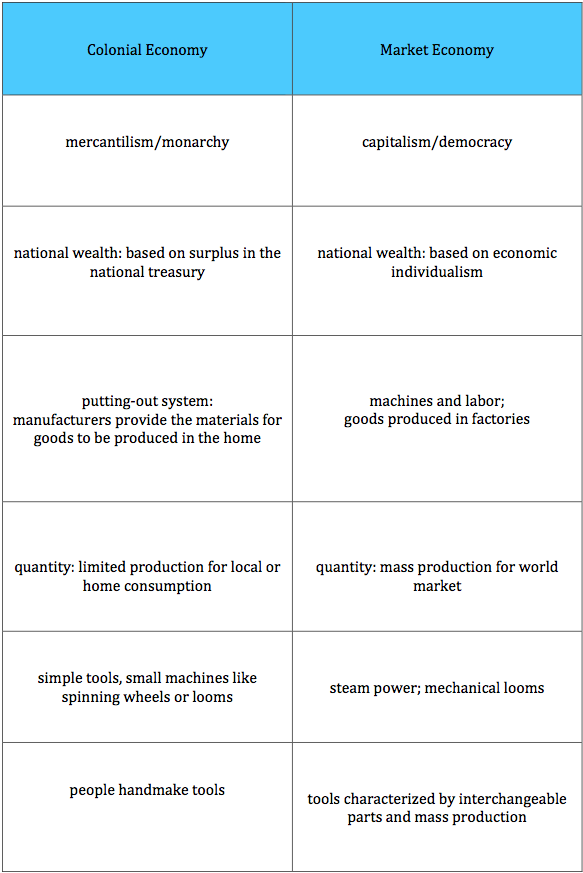What I like about this classroom activity is its simplicity and that it gives students the opportunity to literally manipulate data. I have been continually surprised by how well the very low-tech technique of changing the format of information away from 81/2 X 11 sheets of paper onto small cards works. I suppose one could turn it into some kind of app, but I suspect that for today's youth, they might find index cards novel and the ipad...well, less so. Or maybe I'm just making excuses for my old lesson plans.
I'm pretty sure I got the idea for this lesson after reading Charles Seller's The Market Revolution: Jacksonian America, 1815-1846 in grad school. But I also might have gotten some of it from one of my colleagues, or adapted it from another lesson plan.
So here is the main activity of the lesson:
(Ideally you would need some sort of introduction.) I'm constantly haranguing my student teachers that all good lessons should have a beginning, a middle and an end. This is just the middle.)Copy the chart below onto cardstock. You will need one for each group or pair of students. Small groups or pairs are best. Cut up all the cards and stick each set (mix 'em up) in an envelope.
Have the students first find the cards that say "Colonial Economy" and "Market Economy" and put those at the top. Then have them sort all the cards into one pile for colonial, one for market. They will find it easiest if they FIRST find pairs (e.g. find both national wealth cards). Do one or two with them as an example if you like. This should work well with middle or high school students. You can eliminate some of the cards if you have less time.
Here's the first page of the chart (you can click here for a google doc version that has BOTH pages):
I like to conclude by reminding students about the differences between Hamilton and Jefferson. Do the changes in the economy seem more Hamiltonian or Jeffersonian? And then you can refer to Jefferson's famous comments about manufacturing vs. agriculture from his Notes on the State of Virginia.
"Those who labour in the earth are the chosen people of God, if ever he had a chosen people...."
and
"Dependance begets subservience and venality, suffocates the germ of virtue, and prepares fit tools for the designs of ambition."
You can find the complete text here.
Other resources:
- If you haven't already found them, you should check out John Green's Crash Courses on YouTube. They move pretty fast: there is A LOT of content crammed into videos of 10-15 minutes in length. Because of that, they are probably more suitable to high school level, but you can show parts of them and that would work for middle schoolers. His YouTube video below on the Market Revolution could be used as an intro or conclusion to this lesson. In the 8th minute, Green goes on to explain the connection of the market revolution to other historical trends, such as westward expansion, manifest destiny, immigration, women's work and the "dehuminization" that occurs as a result of industrialization. He concludes with an interesting point about Herman Melville's famous story, "Bartleby, the Scrivener: A Story of Wall Street," which would be an interesting tie-in to literature. But you could also just show the first 8 minutes of this video, if you wanted to keep your lesson more focused on the market economy. (However, you could also include your lesson with a really interesting philosophical discussion of the implications of industrialization.)
- Crash Course also has a video about the invention of the railroad from their World History videos.
- I found the above video from a post on a very useful blog, Freetech4teachers. The author of this award-winning blog used to teach social studies, so lots of the tech stuff is geared towards the social studies. Check out this post on railroads that has links to some other really neat websites, including historypin.org and a video that shows the growth of the railroads.
- I used to use this lesson along with a brief reading about the mills in Lowell, Massachusetts. I'm not sure what I used, but there are quite a few (an understatement) resources to be found at University of Massachusetts Center for Lowell History including this interactive activity and letters from mill girls.


Thanks for this. Exactly what I was looking for to use tomorrow in my AP US class.
ReplyDeleteThanks for the feedback. I hope it worked out well with your students.
ReplyDeleteThis is fantastic. I'm planning to use this tomorrow. Will also sort Market Economy cards into cause and effect. Will look at other posts!
ReplyDeleteThank you. Great lesson. Will use it for this unit.
ReplyDelete